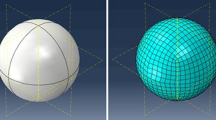Abstract
In this work we propose a particle agglomeration model for chemical mechanical planarization (CMP) under the primary motivation of understanding the creation and behavior of the agglomerated slurry abrasive particles during the CMP process, which are a major cause of defectivity and poor consumable utility due to sedimentation.
The proposed model considers the slurry composition as a colloidal suspension of charged colloidal silica in an electrically neutral aqueous electrolyte. First, a theoretical relationship between the measurable chemical parameters of the slurry’s aqueous electrolyte, the surface potential of the abrasive particles, and corresponding zeta potential between the agglomerated abrasive particles is presented. Secondly, this zeta potential is used in a modified DVLO interaction potential model to determine the particle interaction potentials due to both the attractive van Der Waals forces and repulsive electrostatic interactions. Finally, the total interaction potential created is then used to define a stability ratio for slow versus fast agglomeration and corresponding agglomeration rate equations between particles; these are used in a discrete population balance framework to describe the final particle size distribution with respect to time and agglomerate composition.
The proposed model will provide both a qualitative and quantitative description of agglomeration of abrasive slurry particles during CMP that can be extended to account for slurry composition or abrasive particle type, enabling more accurate process control, increased consumable utility, and possible defectivity reduction.
Similar content being viewed by others
References
F.-C. Chang, S. Tanawade, and R. K. Singh, J. Electrochem. Soc., 156, H39 (2009).
R. Biswas, Y. Han, P. Karra, P. Sherman and A. Chandra, J. Electrochem. Soc., 155, D534–D537 (2008).
M. Moinpour, A. Tregub, A. Oehler, and K.Cadien, Mater. Res. Bulletin, 766, (2002).
F.-C. Chang and R. K. Singh, J. Electrochem. Solid-State Lett., 12, H127–H130 (2009).
A. R. Mazaheri and G. Ahmadi, J. Electrochem. Soc., 150, G233–G239 (2003).
S. Ramarajan, Y. Li, M. Hariharaputhiran, Y.-S. Her, and S. V. Babu, Electrochem. Solid-State Lett., 3(5), 232–234 (2000).
C.L. A. Berli, M.V. Piaggio, J. A. Deiber, Electrophoresis 24, 1587–1595 (2003).
Rollie, H. Briesen, K. Sundmacher, J. Colloid Interface Sci. 336(2), 551–564 (2009).
E.J.W. Verwey and J.T.G. Overbeek, Theory of the Stability of Lyophobic Colloids, Elsevier, Amsterdam (1948).
R. Hogg, T.W. Healy and D.W. Fuerstenau, Trans. Faraday Soc. 62 (1966), p. 1638.
G.R. Wiese and T.W. Healy. Trans. Faraday Soc. 66 (1970), p. 490.
J. M. Steigerwald, S. P. Muraka, and R. J. Guttmann, Chemical Mechanical Planarization of Microelectronical Materials, John Wiley and Sons, New York (1997).
S. H. Li, R. O. Miller. Chemical Mechanical Polishing in Silicon Processing, Academic Press, California, (2000).
M. Elimelech, J. Gregory, X. Jia, and R. A. Williams, Particle Deposition and Aggregation, Butterworth-Heinemann, Oxford (1998).
M. von Smoluchowski, Z. Phys. Chem., 92, 129 (1917).
N. Fuchs, Z. Phys. 89, 736 (1934).
H.C. Hamaker, Physica IV, 2, 1058 (1937).
Brookhaven Instruments Corporation. http://www.bic.com/WhatisZetaPotential.html.
Author information
Authors and Affiliations
Rights and permissions
About this article
Cite this article
Johnson, J.M., Boning, D.S. Slurry Particle Agglomeration Model for Chemical Mechanical Planarization (CMP). MRS Online Proceedings Library 1249, 403 (2010). https://doi.org/10.1557/PROC-1249-E04-03
Received:
Accepted:
Published:
DOI: https://doi.org/10.1557/PROC-1249-E04-03




